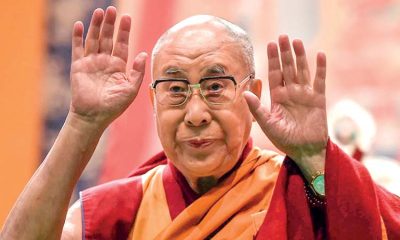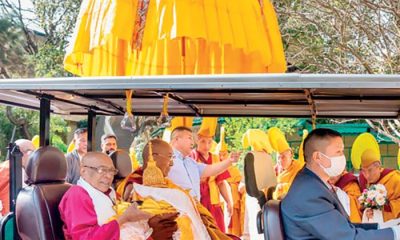Opinion
First Global Buddhist Summit and Dalai Lama – II
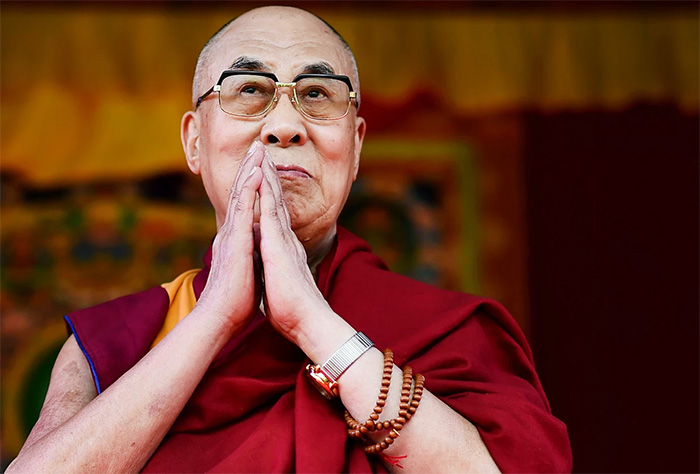
By Rohana R. Wasala
(Continued from yesterday)
The institution of the Dalai Lama as the political and spiritual leader of Tibet may have already lapsed into obsolescence. Probably, no one knows this better than the present Dalai Lama himself. According to Donald Lopez, professor of Buddhist and Tibetan Studies at the University of Michigan, ‘the Dalai Lama has been one of the harshest critics of “old Tibet”….” He adds that the Lama would have introduced political reforms without the Chinese intervention.
Professor Robert Barnett, Director of Modern Tibetan Studies at Columbia University believes that ‘as a political leader, he asks for very little – he seems quite happy to accept a merely symbolic gesture like a cup of tea and a photo’. That may be to put too low a value on his actual political significance. In any case, he has tried to come to an agreement with the Chinese authorities by opting for a degree of autonomy for Tibet while remaining a territory of China, provided it is allowed to enjoy a status that is similar to the status of Hong Kong: a large measure of self-government with its own political and legal systems. He has even indicated his readiness to let Tibet have a communist government, with “meaningful” autonomy, but China will not agree to such a settlement just yet. It may be that with the death of the Dalai Lama (87 this year, 2023) the world might forget Tibet as it was with him living; it will be the end of history for Tibet under its god-king. The Dalai Lama’s lasting legacy for the world will be what he stands for today as a spiritual leader, not as a mundane political figure.
Mainly because of its sizable Tibetan migrant Tibetan community of over 2500, Australia remained a regular destination for the Dalai Lama until about eight years ago. His last visit here, when he was 80, was in 2015 (his 10th visit since 1982). On that occasion, he went to the Uluru sacred site of the native aboriginal community in the Northern Territory to express his respect to their culture. He said:
“In different parts of the world, Indigenous people, local people, they have their own cultural heritage, so that’s the main reason I am here, in order to express my respect to your culture,”
When in an interview with the ABC Television during his earlier visit in Australia in 2013 (he was 78 then) he was asked whether he was upset by the then PM Julia Gillard’s refusal to see him, he said “No. I have no political agenda. … My concern is with the people…My main concern is to promote human values, affection, compassion, harmony….(among them)”. About relations with China, he said that the Tibetans could remain within China, like Hong Kong, but with its own distinct cultural identity intact. He stressed though that “Real change must come from within Tibet, not from outside”.
Professor Barnett points out that the Dalai Lama declared in 2011, in an “Important Proclamation”, that he would make a decision on the problem of succession after consulting with other high lamas and the Tibetan public, and that this would be in 2024. He has also hinted at the possibility of there being no 15th Dalai Lama. But if there is, the Lama has explained, there will be a child identified as his reincarnation after his death or an adult person as an “emanation” chosen by him while he is still alive, and he will leave clear written instructions. In another source which I can’t now remember, he was reported to have confirmed that he will not return to Tibet. This was probably meant to send the Chinese a signal indicating that the time for a peaceful settlement was running out. He was also said to have suggested that his successor could be a woman. But it is generally the case that news hungry journalists misreport their own speculations as assertions allegedly made by the Dalai Lama. His promise to leave written instructions about his succession, Professor Barnett says, was “presumably (intended) to help journalists and others get the story right”. All this goes to prove that the Dalai Lama is no less a politician than a monk.
He set up the Tibetan Central Authority (CTA) , aka Tibetan Government in exile, for the Tibetan exiles in Dharamsala who number about 100,000. But he has relinquished political control of the government in exile. The CTA operates as a democracy with an elected prime minister and parliament. Its constitution is based on Buddhist principles and the Universal Declaration of Human Rights. So, the Dalai Lama seems to have divested himself of serious political responsibility as far as the Tibetan government in exile is concerned. While remaining the head of Tibetan Buddhism, however, he has assumed the role of an ambassador of Buddhism at large to the world. The Dalai Lama remains a symbol of wisdom, peace, and compassion in a world threatened by violence born out of religious fundamentalism and hegemonic geopolitics. Sri Lanka is currently in the grip of the latter twin evils.
The diminishing political stature of the Dalai Lama is being compensated for by his increasing spiritual significance for the world. As a teacher of Buddhism should do, he provides guidance for spirituality without religion (though he does not describe it as such), an urgent need for the world today. Incidentally, I must make it clear that I am aware of the risk I am taking of annoying my readers who accept religions as well as those who reject them or have nothing to do with religions, but I beg that they bear with me, for I don’t mean to hurt their feelings. I am expressing some opinions (relevant to the subject of this essay) that are open to constructive criticism. It is necessary to distinguish between spirituality and religion in trying to explain in what sense the Dalai Lama is important as a spiritual teacher or leader, who is, strictly speaking, not ‘religious’ in the normal theistic sense.
In Buddhism, there is no belief in a creator god who supervises our lives unseen from above and rewards or punishes us eternally according as we obey or transgress his moral law. The Gautama Buddha taught the karma principle, that is, the principle of causality which says that the good intents and actions of an individual bring about good karmic results, and bad intents and actions bad results; no outside power is involved in that, so there is no need to praise, pray to, or otherwise propitiate such an agency. This is one of the senses in which Buddhism is not a religion. Buddha, in fact, did not found a religion, a system of prayer and worship, but explained a non-religious ethical system based on self-realisation, on seeing things as they really are, i.e., on enlightenment. The whole of the Buddhist teaching can be briefly summarised as the Four Noble Truths: that life is suffering, that the suffering is due to a cause, that an end to suffering is available, and that there is a path leading to that end. The principle of causality known as karma underlies this four-term formula of the Buddhist teaching.
So while the concept of spirituality in religions involves a divine dimension, in Buddhism it doesn’t. What is considered spiritual in Buddhism is not tantamount to making contact with the so-called ‘divine’; instead, it consists in attaining heightened mental states through the extinction of the sense of self. A basic teaching of Buddhism is that there is no enduring entity that can be called self (soul); the idea of self is an illusion. ‘Spiritual’ experiences are heightened mental states such as self-transcending love, inner light, ecstasy, bliss which have been found to be common to people of different religions as well as to people who have no religion. Since religions are ideologically different, these phenomena cannot be explained in terms of their unchallengeable dogmas which contradict each other; so there must be a non-religious principle involved, which means that spirituality must be separated from religion. (A good source to consult, for an explanation of what ‘self is an illusion’ means is neuroscientist Dr. Sam Harris’s excellent book ‘Waking Up: Searching for spirituality without religion’ {Random House UK, 2014}. A Kindle edition of the same is also available. It is in this sense that the Dalai Lama should be taken as a spiritual guide, rather than as a religious teacher. The book elaborates a scientific argument that true spirituality consists in realising that the sense of self is an illusion. Dr Harris refers to the Dalai Lama’s participation, representing the Buddhist perspective, in scientific discussions involving the study of consciousness.
It is because of these reasons that Buddhist scholar and former Tibetan monk Robert Thurman, author of ‘Why the Dalai Lama Matters’ (Atria Books, New York, 2008) says that his importance is multifaceted: it can be understood psychologically, physically, mythologically, historically, culturally, doctrinally, and spiritually.
Writing the Introduction to ‘A Force for Good: The Dalai Lama’s Vision for Our World’ by the New York Times best-selling author of ‘Emotional Intelligence’ Daniel Goleman, His Holiness says:
“As a human being I acknowledge that my well-being depends on others and caring for others’ well-being is a moral responsibility I take seriously. It’s unrealistic to think that the future of humanity can be achieved on the basis of prayer or good wishes alone; what we need is to take action. Therefore, my first commitment is to contribute to human happiness as best I can. I am also a Buddhist monk, and according to my experience, all religious traditions have the potential to convey the message of love and compassion. So, my second commitment is to foster harmony and friendly relations between them. Thirdly, I am a Tibetan, and although I have retired from political responsibility, I remain concerned to do what I can to help the Tibetan people, and to preserve our Buddhist culture and the natural environment of Tibet – both of which are under threat of destruction.”
It need hardly be said that the Dalai Lama’s sentiments here strike a chord with Sri Lanka’s majority Sinhalese Buddhist community.
In essence, the Dalai Lama’s message about the importance of moral responsibility based on loving-kindness in resolving most tragic contemporary issues. This is of particular relevance to political leaders of all nations of our time. The Global Buddhist Summit is sure to gain a great deal of momentum in its epoch making endeavour for stimulating a sense of solidarity among all the various sects of Buddhism that are found across the world today from HH Dalai Lama XIV’s exalted participation in its inaugural proceedings. (Concluded.)
Opinion
A national post-cyclone reflection period?
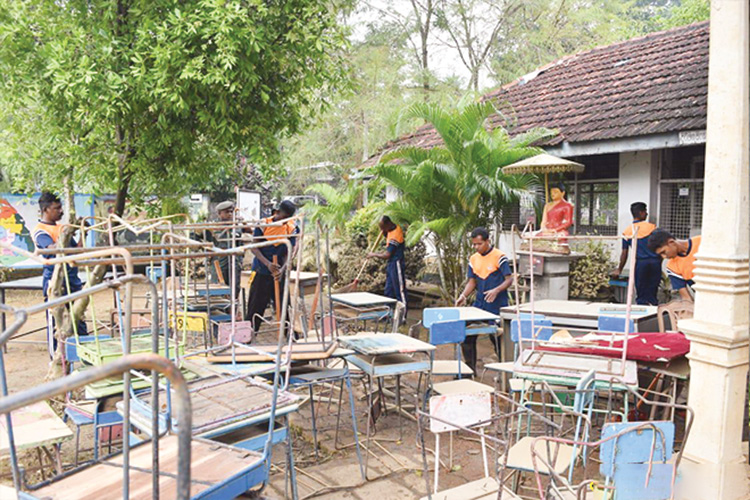
A call to transform schools from shelters of safety into sanctuaries of solidarity
Sri Lanka has faced one of the most devastating natural disasters in its post-independence history. Cyclone Ditwah, with its torrential rains, landslides, flash floods, and widespread displacement, has left an imprint on the nation that will be remembered for decades. While rescue teams continue to work tirelessly and communities rush to rebuild shattered homes and infrastructure, the nation’s disaster assessment is evolving by the day. Funds from government channels, private donations, and the Sri Lankan diaspora are being mobilised and monitored with care. Humanitarian assistance—from the tri-forces and police to religious institutions and village communities—has surged with extraordinary compassion, but as in every disaster, the challenge ahead is not only about restoring physical structures; it is also about restoring the social and emotional fabric of our people for a sustainable future.
Schools on the Frontline of Recovery
The Ministry of Education is now faced with a difficult but essential question: When and how should schools reopen? The complexity of the problem is daunting. Hundreds of schools are either partially submerged, structurally damaged, or being used as temporary shelters, bridges and access roads have collapsed, and teachers and students in highly affected districts have lost family members, homes, and belongings. And yet, not all regions have suffered to the same degree. Some schools remain fully functional, while others will require weeks of rehabilitation.
The country has navigated a similar challenge before. In 2005, following the tsunami that hit mainly the coastal areas of the island, the education system faced a monumental recovery phase, requiring temporary learning spaces, psychosocial support units, and curriculum adjustments. During the COVID-19 pandemic, schools reopened in staggered phases with special protocols. International schools and private educational institutions, with greater autonomy, are likely to restart their academic calendar earlier. Regardless of whether a school belongs to the national, provincial, Pirivena, or international sector, however, education must restart sooner rather than later. The reopening of schools is not merely an administrative decision; it is a symbolic and structural step toward national healing and a restorative future for the country.
Disasters Do Not Discriminate — Neither Should Education
Just like the tsunami of 2004, the major floods of 2016, the landslides of Aranayake (2016), Meeriyabedda (2014), and Badulla (2022), and the Covid-19 pandemic (2021), the cyclone Ditwah has once again exposed the fragile but deeply profound truth that natural phenomena do not recognize distinctions created by humans. Floodwaters do not differentiate between provinces, school systems, or social classes; landslides do not check national exam results before destroying a home; and suffering does not pause to ask whether a child is from a rural Mahaweli village or an elite urban suburb.
In this context, educational institutions have a responsibility that goes far beyond exams and syllabi. This aligns profoundly with an often-cited principle of Jesuit education articulated in 2000 by Fr. Peter-Hans Kolvenbach, S.J., the former Superior General of the Society of Jesus:
Tomorrow’s whole person cannot be whole without an educated awareness of society and culture, with which to contribute socially, generously, in the real world. Tomorrow’s “whole person” must have, in brief, a well-educated solidarity… learned through “contact” rather than “concepts.” When the heart is touched by direct experience, the mind may be challenged to change. Personal involvement with innocent suffering, with the injustice others suffer, is the catalyst for solidarity which then gives rise to intellectual inquiry and moral reflection.”
In this sense, schools must guide children to process what they have witnessed—directly or indirectly—and transform these experiences into moral resilience, empathy, environmental consciousness, and collective responsibility. In doing so, one should bear in mind that every child in Sri Lanka has experienced Cyclone Ditwah in some way:
Children Who Faced the Disaster Directly:
Some children lived through the cyclone in the most harrowing ways—watching floodwaters creep into their homes, escaping rising torrents, or fleeing as landslides tore through familiar ground. Their memories are filled with the sound of rushing water, collapsing earth, and the frantic efforts of parents and neighbours, losing their family members, and trying to keep everyone safe.
Children Who Supported Frontline Families:
Others experienced the crisis through the lens of responsibility. They watched fathers, mothers, siblings, or relatives join rescue teams, distribute supplies, or help evacuate neighbours. These children carried a different kind of fear—waiting in silence, praying that their loved ones would return safely from dangerous missions.
Children Who Witnessed the Disaster Through Media:
Many encountered the cyclone from within their homes or shelters, glued to phones, televisions, and social media feeds. They saw images of villages underwater, families stranded on rooftops, frantic cries for help, boats battling fierce currents, and choppers airlifting stranded people. Even from a distance, these scenes left deep emotional imprints.
Children Who Internalised the Atmosphere of Fear:
Some were not exposed directly to images or destruction, but absorbed the tension in their households—whispered conversations, worried faces, disrupted routines, and sleepless nights. Their experience was shaped by the emotional climate around them: the uncertainty, the stress, and the unspoken fear shared by the adults they depend on.
Children Who Got Involved in Relief Efforts:
Across Sri Lanka, countless children became active participants in relief efforts—some spontaneously, others through families, schools, churches, temples, mosques, and youth groups. Individually, they helped neighbors carry belongings, comfort younger children who were frightened, fetch water and dry rations, and assist the elderly in evacuation centers. Within families, many helped prepare meals for displaced people, sorted clothing donations, packed dry-food parcels, and joined parents in visiting affected households. Through organizations, such as temples, churches, mosques, charity foundations, school associations, clubs, scout groups, Girl Guides, Sunday school units, youth groups, and student unions, children coordinated collection drives, raised funds, gathered books and uniforms for those who are affected, and volunteered at distribution points. These acts, small and large, are beacons of the nation’s hope, revealing that even a crisis as destructive as Cyclone Ditwah, Sri Lankan children were not only making meaning of suffering, but also cultivating compassion, solidarity, and shared responsibility.
In one way or another, Sri Lanka’s children have been touched by the experience. Their hearts are stirred. Their minds are open. While not all trauma comes from direct contact, indirect exposure can be equally jarring, especially for younger children; their psychological, emotional, and social well-being must be handled with sensitivity and foresight. This moment, therefore, is an educational opportunity of rare depth—if we have the courage and creativity to embrace it.
A National Post-Cyclone Reflection Period (NPCRP)?
Once schools reopen, no child should simply return to the classroom as if nothing happened. A top-down insistence on “catching up” academically without addressing emotional wounds will only store up psychological problems for the future. Instead, schools should designate an initial period for reflection, storytelling, sharing, healing, and meaning-making. Hence, a mandatory National Post-Cyclone Reflection Period (NPCRP) is not merely a “feel-good” recommendation. It draws from post-tsunami educational reforms both in Sri Lanka (2004) and in Japan (2011), WHO frameworks for psychosocial healing in schools, UNICEF guidelines on post-disaster learning environments, and our own cultural traditions of collective mourning and remembrance in Sri Lanka. In Sri Lanka, villages often come together after a death for almsgivings, month-mind ceremonies, etc. Our religions—Buddhism, Christianity, Islam, and Hinduism—each emphasize compassion, reflective mourning, and community healing. Why should schools not embody these cultural strengths after a catastrophe that has impacted an entire nation?
(To be concluded)
(Dr. Rashmi M. Fernando, S.J., is a Jesuit priest, educator, and special assistant to the provost at Loyola Marymount University, Los Angeles, California, USA.).
by Dr. Rashmi M. Fernando, S.J.
Opinion
Venerable Mettavihari Denmarke passes away

Danish Monk Who Revolutionised Digital Buddhism and World’s Buddhist Media
The Buddhist community in Sri Lanka and around the world is mourning the passing of Venerable Mettavihari Denmarke, the Danish-born monk whose pioneering work transformed the modern dissemination of Theravada Buddhism. He passed away peacefully in Denmark recently, after battling with cancer.
Born Jacub Jacobson, a Christian and a successful businessman in Denmark for more than 18 years, he was drawn to the timeless truth of the Four Noble Truths and the serenity of the Noble Eightfold Path. This spiritual awakening led him to the Buddhist Order, where he was ordained under Ven. Agga Maha Panditha Madihe Pannaseeha Maha Nayake Thera, receiving the name Bhikkhu Mettavihari.
A Life Rooted in Sri Lanka
Venerable Mettavihari first arrived in Sri Lanka in 1969 and immediately felt a deep connection to the island and its people. Inspired by the purity of the Dhamma, he made Sri Lanka his permanent home. In 1988, both he and his wife entered the Buddhist Order – he as a monk and she as a nun dedicating themselves wholeheartedly to the Sasana.
Remembered for Compassion and Humility
I was fortunate to associate with him for over 10 years on several projects. His kindness towards all living beings and his sincere practice of the Dhamma were exemplary even for monks.
I recall one occasion when he attended a full-day workshop on neuroscience and Buddhism simply to encourage me. He stayed throughout, offering blessings and support. That day the devotees responsible for bringing Dana were late, yet he asked only for a piece of bread, as he was committed to maintaining the Vinaya discipline of eating before noon.
He was often seen walking barefoot on alms rounds gentle, humble, and entirely detached from worldly comforts.
His studio was always open to me, welcoming any noble work and encouraging efforts to help people lead meaningful, wholesome lives.
He was a strict Vinaya practitioner, a monk of exceptional discipline, simplicity, integrity, compassion, loving-kindness, and empathy that were beyond imagination.
A Pioneer of Digital Buddhism
Before his ordination, Venerable Mettavihari worked in the IT field in Denmark. He used this expertise to usher Buddhism into the digital age.
Through metta.lk, he created one of the world’s earliest online Buddhist databases, digitising the Tripitaka and making it available in three languages. He also provided email services to temples and ensured that Dhammapada verses accompanied each message quietly spreading the Dhamma across the globe.
Founder of Dharmavahini – Sri Lanka’s First Buddhist TV Channel
He founded Dharmavahini, Sri Lanka’s first Buddhist television channel, run by a small team of volunteers with minimal resources. More than a broadcaster, Dharmavahini was his effort to restore forgotten values in Sri Lankan society.
Today, it remains a landmark contribution to Buddhist media.
Educational Reformer – Founder of Learn TV
After witnessing the educational challenges faced by rural children following the 2004 tsunami, Venerable Mettavihari launched Learn TV, a 24-hour educational channel developed with the Ministry of Education.
This enabled thousands of students, especially those without tuition or teachers, to receive continuous, curriculum-based lessons from home.
A Monk Who Became Sri Lankan at Heart
Fluent in Sinhala and immersed in Sri Lankan culture, he often referred to himself simply as “a Sri Lankan.” During a conversation with friends, he humorously admitted that speaking Danish had become difficult, “because I am now a Sri Lankan.”
Noble Life and a Lasting Legacy
Most Venerable Mettavihari (aged 80)
With boundless compassion and humility, he uplifted countless lives through education, media, technology, and the Dhamma.
His legacy includes:
- Digitising the Tripitaka and pioneering online Buddhist resources
- Establishing Dharmavahini, Sri Lanka’s first Buddhist TV channel
- Launching Learn TV to uplift rural education
- Advancing global Buddhist communication through IT
- Strengthening moral values in Sri Lankan society
He was also an ardent supporter of the Light of Asia Foundation since its inception. He supported and guided the production of the Siddhartha movie, the establishment of the Sakya Kingdom, the International Film Festival, and, just a few months ago, he participated in the first production of a short video series on the Sutta which is currently under production and expected to be launched soon.
His life stands as a rare example of innovation, devotion, and deep spiritual conviction.
Venerable Mettavihari passed away mindfully at his home in Denmark.
His passing is a profound loss not only for Sri Lanka, but for the world.
May this noble monk attain the supreme bliss of Nibbana
Lalith de Silva
Former President, Vidyalankara Maha Pirivena Trustee, Light of Asia Foundation
Opinion
Maha Jana Handa at Nugegoda, cyclone destruction, and contenders positioning for power in post-NPP Sri Lanka – I
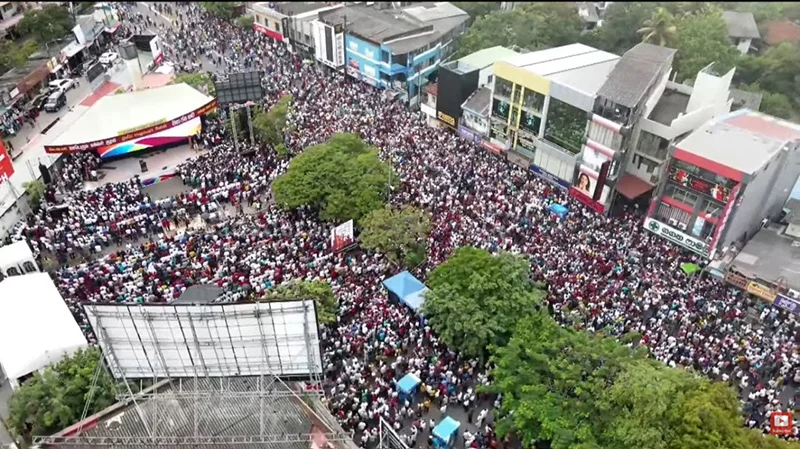
The Joint Opposition rally dubbed the ‘Maha Jana Handa’ (Vox Populi/ Voice of the People) held at the Ananda Samarakoon Open Air Theatre, Nugegoda on 21 November, 2025 has suddenly acquired a growing potential to be remembered as a significant turning point in post-civil conflict Sri Lankan politics, in the wake of the meteorological catastrophe caused by the calamitous Ditwah cyclonic storm that devastated the whole country from north to south and east to west on an unprecedented scale. But the strength of this prospect depends on the collective coordinated success of the future public awareness raising rallies, promised by the participating opposition parties, against the incumbent JVP-led NPP government. They are set to expose what they perceive as the government’s utterly inexperienced and unexpectedly authoritarian stand on certain vitally important issues including the country’s national security and independence, political and economic stability, and the Lankan state’s unitary status. The government is also alleged to be moving towards establishing a form of old-fashioned single party Marxist dictatorship in place of the firmly established system of governance based on parliamentary democracy, which was almost toppled by the adventitious Aragalaya protest of 2022 but saved by the timely intervention of some patriotic elements.
The minefield of policy making that the government must negotiate is strewn with issues including, among others: the seven or so recent agreements or MOUs (?) secretly signed with India; the unresolved controversy over the allegedly illegal clearance of some 323 containers (with unknown goods) without mandatory Customs inspection, from the Colombo Port; the Prime Minister’s arbitrary, apparently ill-considered and hasty education reforms without proper parliamentary discussion; the proposed culturally sensitive lgbtqia+ legislation non-issue (it is a non-issue for Sri Lanka, given its dominant culture); the so-called IMF debt trap; dealing with the unfair, virtually unilateral UNHRC resolutions against Sri Lanka; the inexplicably submissive surrender of the control of the profit-making Colombo Dockyard PLC to India; some government personal assets declarations that have raised many eyebrows, and the government’s handling of anti-narcotic and anti-corruption operations. The opposition politicians relentlessly criticise the ruling JVP/NPP’s failure to come out clean on these matters. But they themselves are not likely to be on an easy wicket if challenged to reveal their own positions regarding the above-mentioned issues.
In addition to those problems, the much more formidable challenge of unsolicited foreign-power interference in Sri Lanka’s internal affairs, in the guise of friendly intervention, remains an unavoidable circumstance that we are required to survive in the geostrategically sensitive region where Sri Lanka is located. Having been active right from the departure of the British colonialists in 1948, the foreign interference menace intensified after the successful ending of armed separatist terrorism in 2009. Such external interferences are locally assisted by latent domestic communal disharmony as well as real political factionalism, both of which are normal in any democratic country.
The war-winning President Mahinda Rajapaksa, as the leader of the SLFP-led United People’s Freedom Alliance (UPFA), was made to suffer a largely unexpected electoral defeat in 2015 through a foreign-engineered regime change operation that tacitly favoured his key rival, UNP leader Ranil Wickremesinghe. Mahinda was betrayed by his most trusted lieutenant Maithripala Sirisena.
The SLFP, a more middle of the way socialist-leaning rival political party, was formed in September 1951—five years after the birth of the UNP—and was elected to power in 1956, ending a near decade under the rather West-friendly latter party. It was deemed to be a ‘revolution’ that started an era of ‘transition’ (from elitist to common citizen rule). From nominal independence in 1948, governing power has to date alternated between these two parties or alliances led by them, except for the last electoral year, 2024. Though incumbent Executive President Anura Kumara Dissanayake may be said to have made history in this sense, the fact remains that he was barely able to scrape just 43% of the popular vote as the head of a newly formed, JVP-led NPP. Dissanayake was sworn in as President in September 2024. But his less than convincing electoral approval triggered a massive victory for the NPP at the parliamentary election that followed in November, giving him a parliament with 159 members, which is unprecedented in Sri Lanka’s electoral history.
In my opinion, there are two main reasons for this outcome. One is that the average Sri Lankan voters trust democracy. Since the president elect is accepted as having won the favour of the majority of the pan-Sri Lankan electorate, the general public choose to forget about their personal party affiliations and tend to vote for the parliamentary candidates from the party of the elected president. This is particularly true of the majority Sinhalese Buddhist community represented by the two mainstream, non-communal national parties, the UNP and the SLFP. The brittle foundation of that victory is not likely to sustain a strong enough administration that is capable of introducing the nebulous ‘system change’ that they have promised in their manifesto, while it is becoming clear that the general performance of the government seems to be falling far short of the real public expectations, which are not identical with the unconscionable demands made by the few separatist elements among the peaceful Tamil diaspora in the West, to whom the JVP/NPP alliance seems to owe its significantly qualified electoral success in 2024.
The Maha Jana Handa reminded me of the long Janabalaya Protest March from Kandy to Colombo where it ended in a mass rally on September 5, 2018. That hugely successful event was organised by the youth wing of the SLPP led by Namal Rajapaksa, who was an Opposition MP during the Yahapalanaya. He has played the same role just as efficiently on the most recent occasion, too. At the end of his address during the Maha Jana Handa, he declared his determination to bring down the malfunctioning JVP/NPP government at the earliest instance possible. Probably, he missed Ranil’s protege Harin Fernando’s speech that came earlier. This was because Namal Rajapaksa joined the rally midway. Harin had brought a message from his mentor Ranil to be read out to the rally audience. But he said he didn’t want to do so after all, saying that it was not suitable for that moment. Anyway, during his speech, Harin said emphatically that the era of heirs apparent or crown princes was gone for good. People knew that he was alluding to Sajith Premadasa and Namal Rajapaksa (sons of former Presidents hopeful of succeeding Anura Kumara Dissanayake). Harin was seen biting his tongue or sticking it out a little as he was preparing to leave the stage at the end of his address. Was he regretting what he had just said or was he cocking a snook at what, he was sure, was Namal’s ambition that would be revealed in his speech, the rally having been organised by the Pohottuwa or the SLPP? (To be continued)
by Rohana R. Wasala
-

 News3 days ago
News3 days agoOver 35,000 drug offenders nabbed in 36 days
-

 News6 days ago
News6 days agoLevel III landslide early warning continue to be in force in the districts of Kandy, Kegalle, Kurunegala and Matale
-

 Business5 days ago
Business5 days agoLOLC Finance Factoring powers business growth
-

 News5 days ago
News5 days agoCPC delegation meets JVP for talks on disaster response
-

 News5 days ago
News5 days agoA 6th Year Accolade: The Eternal Opulence of My Fair Lady
-

 News2 days ago
News2 days agoCyclone Ditwah leaves Sri Lanka’s biodiversity in ruins: Top scientist warns of unseen ecological disaster
-

 News3 days ago
News3 days agoRising water level in Malwathu Oya triggers alert in Thanthirimale
-
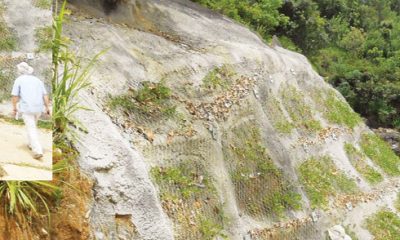
 Features4 days ago
Features4 days agoThe Catastrophic Impact of Tropical Cyclone Ditwah on Sri Lanka:


